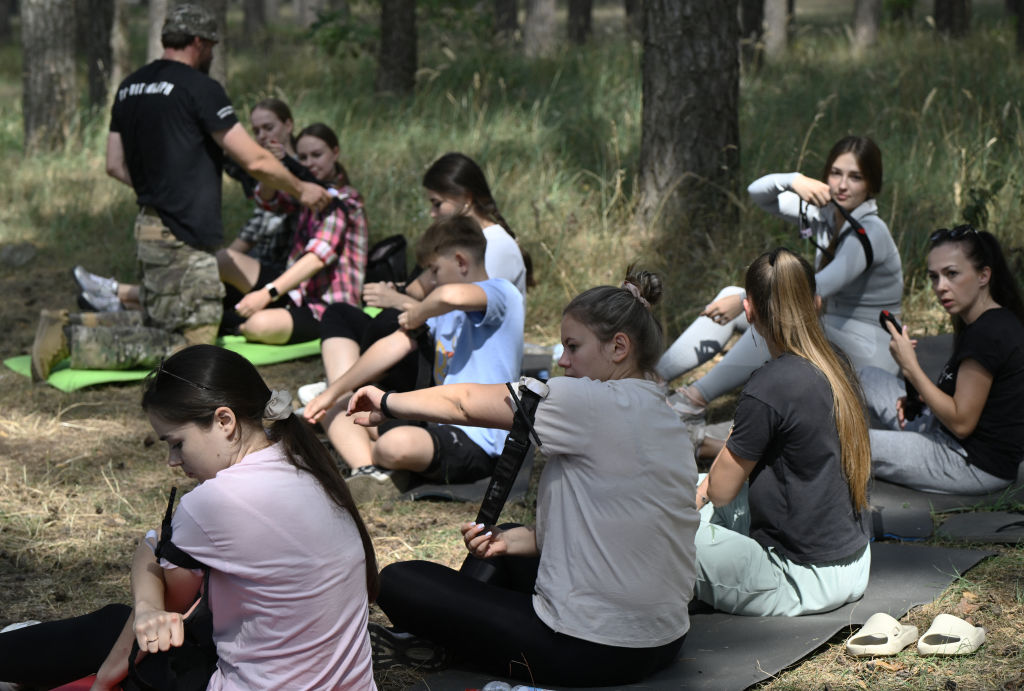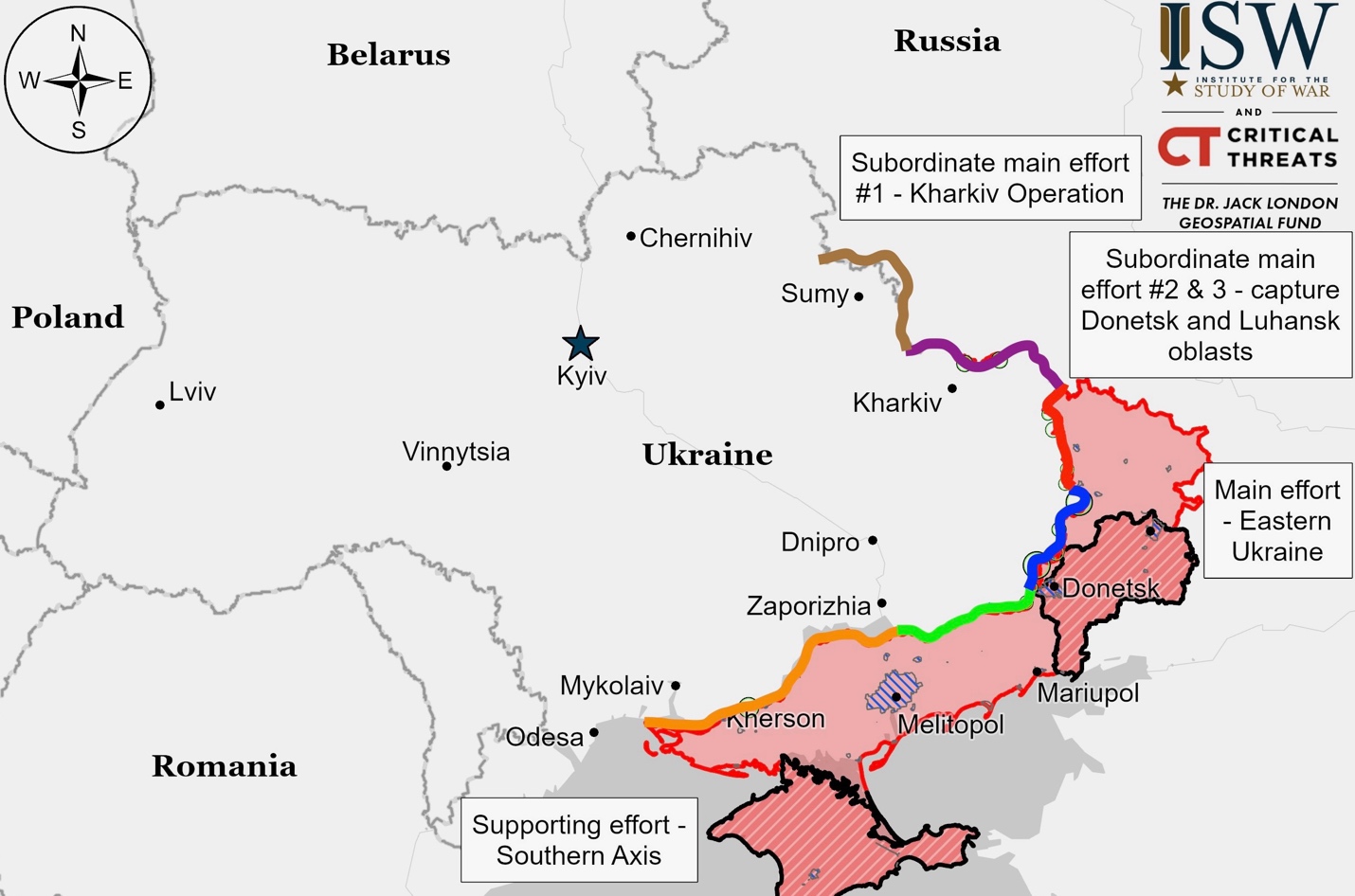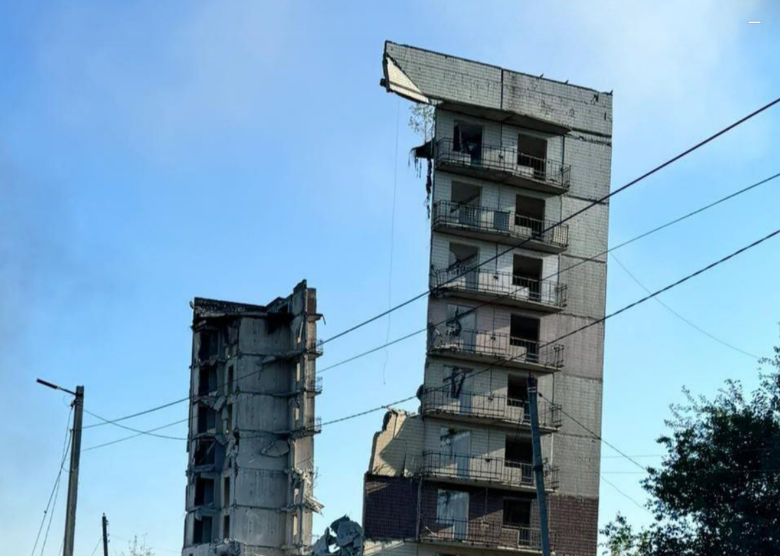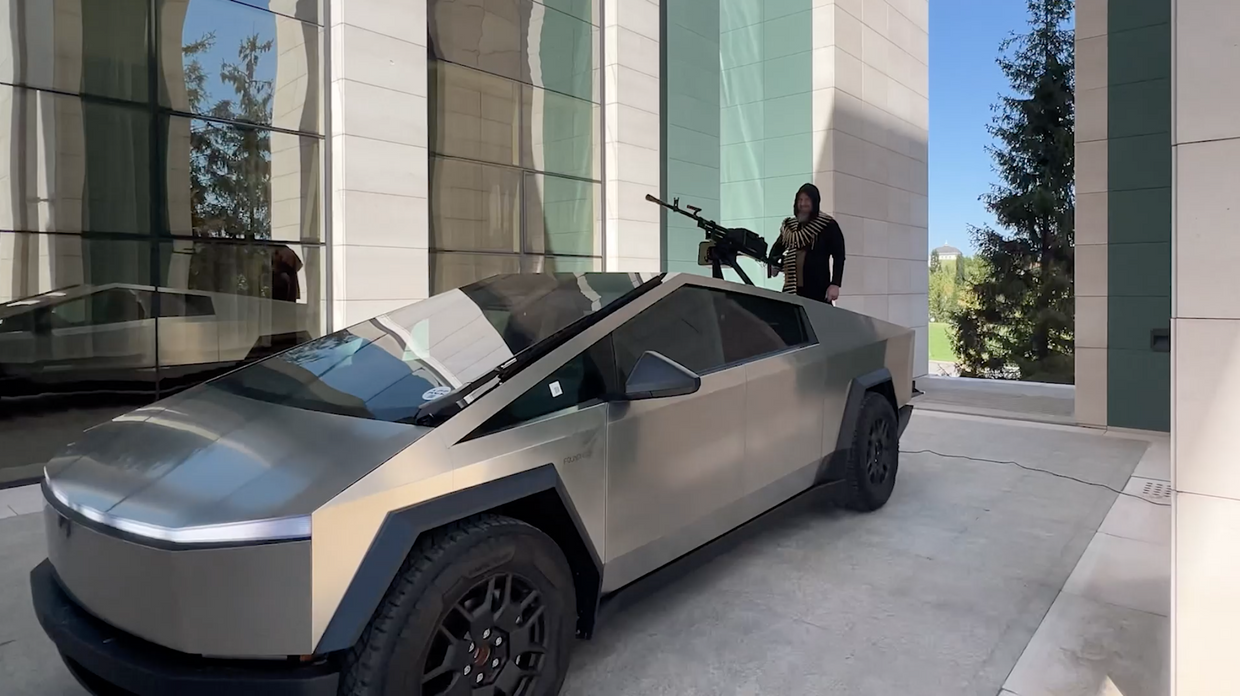Summary of the day: The situation in Ukraine and Russia remains tense and complex, with recent military actions illustrating a protracted conflict that is unlikely to be resolved through single, decisive operations. Both Russian and Ukrainian forces are engaged in operations that are part of a broader strategy to achieve incremental gains, rather than outright victory. The Ukrainian incursion into Kursk Oblast and Russian offensives in eastern Ukraine, particularly near Kreminna, Pokrovsk, and Donetsk City, exemplify this approach. Ukrainian forces have notably advanced within Chasiv Yar, signaling a continued push against Russian positions.
The significance of these military movements is more about their cumulative impact over time than any immediate strategic shifts. According to assessments, neither side possesses the capability to conduct war-winning operations independently; instead, they rely on successive operations to gradually achieve strategic objectives. This method of warfare, characterized by the Russians’ use of positional warfare and the Ukrainians’ maneuver warfare, reflects each side’s adaptation to the other’s strengths and vulnerabilities.
Strategically, the Russian government views maintaining the initiative across the theater as crucial, particularly in a war of attrition, which they aim to win through gradual advances. Conversely, Ukraine’s operations, such as the one in Kursk Oblast, although not aimed at holding territory, are designed to create operational and strategic pressures across the theater, challenging Russian forces and potentially shifting the initiative. The ongoing conflict and its developments suggest that both sides are preparing for prolonged engagement, with the Russian government also using programs like “Time of Heroes” to bolster its governmental roles with trusted military veterans. Meanwhile, diplomatic efforts seem stalled, with Russia showing little interest in meaningful negotiations, highlighted by the postponement of a summit in Qatar intended to discuss a moratorium on strikes against energy infrastructure, a response to Ukraine’s persistent strike campaign. The course of the war remains uncertain, with both sides adapting to a dynamically evolving battlefield.
Picture of the day:
 Young people attend an emergency first aid demonstration by paramedic volunteers from Ukraine’s Hospitallers voluntary organization in the city of Sumy. (Genya Savilov/AFP via Getty Images)
Young people attend an emergency first aid demonstration by paramedic volunteers from Ukraine’s Hospitallers voluntary organization in the city of Sumy. (Genya Savilov/AFP via Getty Images)
What Can I Do To Help Ukraine? This is a question I receive all the time. We at Transform Ukraine are building longer-term housing for internally displaced Ukrainians. Visit Rebuild Ukraine for how you can assist in housing a Ukrainian family displaced by the war.
Beyond Ukraine – The March Towards World War
The Russian Ministry of Foreign Affairs announced that Deputy Foreign Minister Mikhail Galuzin met with Belarusian Ambassador Alexander Rogozhnik on August 15. They discussed executing existing bilateral agreements, drafting new ones within the Union State framework, and planning future diplomatic engagements.
The Path To Peace
Negotiations between Russia and Ukraine over a moratorium on energy infrastructure strikes, initially set for face-to-face meetings in Doha, have been complicated by geopolitical dynamics. The talks, shifted to a videoconference on August 22, 2024, due to Ukraine’s military activities in Kursk Oblast and tensions in the Middle East, highlight a cautious engagement from both sides. Russia, while showing limited interest in comprehensive peace negotiations, has strategically delayed discussions, possibly in response to Ukraine’s targeted strikes on Russian oil refineries. Despite this, Russia maintains a hardline stance, requiring Ukrainian capitulation and rejecting any form of ceasefire, which President Putin argues could strengthen Ukraine militarily.
Meanwhile, Ukraine, anticipating potential Russian withdrawal from agreements, seeks to strengthen the proposed moratorium by involving international partners, ensuring broader enforcement and accountability. This move is partly influenced by past Russian exits from agreements under questionable pretexts, such as the non-renewal of the Black Sea Grain Initiative, which Russia ended by disputing the distribution claims of the grain, contrary to United Nations data. Nonetheless, Ukraine continues to push its military advantage in the Black Sea to sustain grain exports despite Russia’s cessation of the agreement.
In essence, the path to peace is fraught with strategic maneuvers and diplomatic challenges, with both nations preparing for long-term engagement while tentatively exploring agreements that could stabilize hostilities, albeit with guarded expectations on both sides.
Situation On The Land, Sea, and Air in Ukraine
In the shifting tides of the Ukraine-Russia conflict, neither nation can clinch a decisive victory through isolated operations. Instead, both countries have entrenched themselves in a war of attrition, focusing on gradual territorial gains and strategic pressures rather than swift, conclusive victories. The battlefields of Kursk Oblast and eastern Ukraine are scenes of persistent conflict, where Ukrainian incursions and Russian defensive maneuvers illustrate a complex dance of advance and retreat.
Russian President Vladimir Putin, aiming for long-term control, directs operations to stretch Ukrainian resources thin, targeting Donetsk and Luhansk oblasts for comprehensive control. In these areas, Russia’s strategy revolves around slow, incremental gains, as seen in their methodical advance toward Pokrovsk, underpinning a broader strategy of wearing down Ukrainian defenses through continued pressure and attrition.
Concurrently, Ukraine’s tactics in Kursk Oblast, while not aimed at permanent territorial acquisition, disrupt Russian logistics and force costly redeployments. These maneuvers create strategic dilemmas for Russia, challenging its ability to maintain a sustained offensive across the region. Ukrainian forces, using strategic pressures effectively, have managed to initiate a dynamic of rapid territorial gains, demonstrating the potential to alter the operational tempo and shift the conflict’s momentum.
This ongoing struggle underscores a critical aspect of modern warfare where strategic patience and resource management become as crucial as battlefield tactics. Both nations are preparing for a protracted conflict, evidenced by their strategic reserves and defensive postures, suggesting a war that will continue to evolve slowly, punctuated by moments of intense confrontation and strategic maneuvering. The ultimate outcomes of these operations remain uncertain, as the conflict’s dynamic nature promises more twists in the narrative of this modern, protracted war.
The Russian Ministry of Defense reported that the Black Sea Fleet neutralized two Ukrainian naval drones near occupied Crimea.

Kursk Front – Initiative Ukraine
Ukrainian forces are making slight advancements in Kursk Oblast despite Russian efforts to halt their progress and push them back. Russian military bloggers reported on August 17 that Russia had destroyed several bridges near the Seim River to prevent Ukrainian advances. Meanwhile, Ukrainian troops have fortified positions along the river’s west bank. There are ongoing operations around Tetkino and south towards Troitskoye, with movements also noted west and south of Snagost. Additionally, Ukrainian assaults are reported northeast of Korenevo, including near Kauchuk and Alekseyevsky. Footage also shows Ukrainian activity in western Russkoye Porechnoye, north of Sudzha. Further northeast and southeast of Sudzha, Ukrainian forces are advancing, while Russian bloggers claim Russian forces have regained areas like Ozerki, Kamyshnoye, and Giri. The situation remains dynamic with continuous military engagements in these areas.
Ukraine’s rapid incursion into Kursk Oblast demonstrates the effectiveness of maneuver warfare in overcoming Russian advantages in manpower and materials. From August 6 to 12, Ukrainian forces advanced approximately 800 square kilometers and reached a depth of 28 kilometers, contrasting with the slower Russian territorial gains of 1,175 square kilometers over seven months. This swift Ukrainian advance exploited weak Russian defenses and continued even after Russian reinforcements arrived. Such dynamic tactics highlight Ukraine’s ability to achieve significant territorial gains quickly, despite resource limitations, compared to the slow progress of positional warfare. This strategy, emphasizing operational surprise and mobility, may shape future Ukrainian approaches in the conflict.
Kharkiv Front – Initiative Russia
Russian forces intensified ground assaults north and northeast of Kharkiv City, particularly near Lyptsi, Hlyboke, and Vovchansk. The Ukrainian Kharkiv Group of Forces noted that Russian units are bolstering their positions and coordinating operations in these areas.
Luhansk Front – Initiative Russia
Russian forces achieved minor advancements near Kreminna and engaged in ongoing battles along the Kupyansk-Svatove-Kreminna line. Geolocated footage shows slight progress in northeastern Makiivka. Russian troops launched attacks in several areas including southeast of Kupyansk, northwest and west of Kreminna.
Donetsk Front – Initiative Russia
Siversk
Russian forces carried out ground attacks around Siversk from multiple directions, including northeast, east, southeast, and south, but the frontline positions remained unchanged. Russian assault forces were particularly active near Pereizne.
Chasiv Yar
Ukrainian forces achieved slight advances in eastern Chasiv Yar, particularly along the west bank of the Siverskyi-Donets Donbas Canal. Additionally, efforts to regain positions in a nearby forest west of Klishchiivka were reported. Meanwhile, Russian forces continued their offensive north of Chasiv Yar near Hryhorivka, although claims of Russian advances in Chasiv Yar’s Zhovtnevyi Microraion remain unverified.
Toretsk
Russian forces continued their offensive towards Toretsk but did not achieve confirmed changes to the frontline. Russian milbloggers reported advancements towards Toretsk from Pivnichne and towards Nelipivka from Zalizne. Additionally, claims of Russian control over approximately 80% of Niu York south of Toretsk are unverified. The Ukrainian General Staff noted ongoing Russian assaults near Toretsk, specifically north near Bila Hora and Dyliivka, and south near Panteleymonivka.
Pokrovsk
Russian forces made a slight advancement southeast of Pokrovsk, amidst broader confrontations in the area. Geolocated footage shows marginal Russian gains southeast of Zhelanne and Ukrainian forces repelling a Russian assault near Lozuvatske. Russian claims of capturing Novozhelanne and advancing in surrounding areas like Krutyi Yar and Hrodivka remain unverified. Ukrainian military sources note that Russian main force concentrations persist in eastern Ukraine without significant redeployments from Pokrovsk. Russian offensives also continued near Pokrovsk in locations such as Vozdvyzhenka, Myrolyubivka, Mykolaivka, Zelene Pole, Zhuravka, Zavitne, and Ptyche.
Southwest of Donetsk City
Russian forces achieved minor advancements southwest of Donetsk City during mechanized assaults. Geolocated footage confirmed a slight advance northwest of Pobieda. Concurrently, Ukrainian forces successfully repelled a Russian mechanized assault west of Donetsk City, destroying several Russian armored vehicles and forcing a retreat. Further offensive operations by Russian forces occurred near Krasnohorivka, Heorhiivka, and Kostyantynivka.
Zaporizhia Front – Initiative Russia
Zaporizhia-Donetsk Border Area
There were no comments from Russian or Ukrainian sources regarding the situation at the Donetsk-Zaporizhia Oblast border.
Zaporizhia Line
Positional fighting persisted in western Zaporizhia Oblast near Mala Tokmachka with no changes to the frontline. Ukrainian spokesperson Captain Dmytro Lykhovyi reported minor troop movements by Russian forces in the area but emphasized that there has not been a significant redeployment of forces to Kursk Oblast. Approximately 1,000-2,000 of the 75,000-90,000 Russian troops stationed in Zaporizhia Oblast have moved to Kursk.
Kherson (Dnipro River) Front – Initiative Russia
Russian forces attacked east bank Kherson Oblast without making confirmed gains. Russian forces were engaged near Krynky and operated near islands in the Dnipro River delta.
Ukraine News
Russian forces launched missile and drone strikes on various Ukrainian rear areas. They targeted Sumy City with an Iskander-K cruise missile from Voronezh Oblast and deployed 14 Shahed drones from locations in Krasnodar Krai and Kursk Oblast. Ukrainian Air Force Commander Lieutenant General Mykola Oleshchuk reported that all drones were intercepted over regions including Mykolaiv, Cherkasy, Poltava, Dnipropetrovsk, Zaporizhia, and Kyiv. In Sumy, the missile hit a civilian target. Russian claims included strikes on Ukrainian military assets in Sumy and Dnipropetrovsk oblasts, including air defense systems and an aircraft.
Ukrainian Ombudsman Dmytro Lubinets has reported Russian war crimes involving the desecration of a Ukrainian soldier’s body, prompting appeals to the United Nations and the International Committee of the Red Cross. The incident, captured in a video showing a Russian serviceman with the desecrated body, has led to an investigation by the Ukrainian Prosecutor’s Office. This video, reportedly from the Kolotilovka border checkpoint in Belgorod Oblast and featuring a logo of the Russian 155th Naval Infantry Brigade, aims to demoralize Ukrainians. The status of the soldier as a prisoner of war remains unconfirmed. (Russian War Crime)
Monobank, Ukraine’s largest direct bank, has been under continuous DDoS attacks for two days, co-owner Oleh Horokhovskyi reported. The attacks generated nearly 3 billion service requests. While Horokhovskyi hinted at Russian involvement, no specific culprit was identified. Monobank has faced similar attacks before, including a major DDoS attack in January. Russia has conducted numerous cyberattacks against Ukraine since the invasion, while Ukrainian hackers, including the IT Army, have retaliated with their own cyber operations.
Volodymyr Zhovnir, CEO of Kyiv’s Okhmatdyt children’s hospital, was suspended pending inspections related to the hospital’s reconstruction, Health Minister Viktor Liashko announced. The hospital, Ukraine’s largest children’s medical center, was heavily damaged in a Russian missile attack on July 8. Over Hr 1 billion ($24 million) was raised for its reconstruction, but concerns arose after a high-cost bid by Bud-Technology won the rebuilding tender. Amid public outcry, Liashko ordered a new tender and cited “distortion of key information” in the ongoing investigation. Zhovnir will be temporarily replaced by Oleksandr Urin, and further reconstruction will be supervised by a newly-formed Restoration Council.
Innocent Victims Of War
The casualty count of civilians in the past 24 hours:
DEATHS: 4 INJURIES: 14
- Russian forces attacked Myrnohrad in Donetsk Oblast killing at least one person and injuring four others. The town, located just east of the key logistics hub Pokrovsk and close to the front line, was hit by a strike on an unfinished nine-story building. The casualty count may rise as search efforts continue. (Russian War Crime)
- Russian forces attacked Sumy injuring at least two civilians. An Iskander-K missile and a KAB bomb were used in the attack, causing 10 parked cars to catch fire and damaging nearby buildings’ windows and facades. (Russian War Crime)
- In Donetsk Oblast, one person was killed and another injured in Toretsk, while Chasiv Yar and Siversk each reported one civilian casualty, with one killed and one injured respectively.
- A woman was killed in a Russian attack on the village of Kozacha Lopan in Kharkiv Oblast.
- Russian attacks on Kherson Oblast injured six people, including a child, and damaged a critical infrastructure facility, multi-story buildings, and 22 houses. (Russian War Crimes)
 Russian forces attacked an unfinished high-rise building in the town of Myrnohrad in Donetsk Oblast. (Vadym Filashkin/Telegram)
Russian forces attacked an unfinished high-rise building in the town of Myrnohrad in Donetsk Oblast. (Vadym Filashkin/Telegram)
 Cars on fire following a Russian attack against Sumy, Ukraine. (State Emergency Service/Telegram)
Cars on fire following a Russian attack against Sumy, Ukraine. (State Emergency Service/Telegram)
Ukraine’s Allies
The UK is awaiting US approval to allow Ukrainian forces to use UK-provided Storm Shadow missiles for long-range strikes against military targets in Russia. This request, submitted in mid-July 2024, is part of a broader discussion involving the UK, US, France, and another unnamed NATO ally, which requires unanimous consent for policy changes. Despite ongoing discussions, the UK’s stance on Ukraine’s use of these missiles has been inconsistent, with several contradictory statements from UK officials recently reported.
Former British Prime Minister Boris Johnson urged the U.S. and U.K. to allow Ukraine to use long-range ATACMS and Storm Shadow missiles to strike Russian territory. Johnson criticized the current restrictions, arguing that Ukraine should have the freedom to target Russian military sites to stop attacks on its cities. He praised the British government’s past leadership in supplying weapons to Ukraine and called on current leaders to take similar decisive action. Johnson also commended Ukraine’s recent incursions into Russia, highlighting their unexpected success and the resilience of the Ukrainian people.
Two Italian journalists from RAI will return to Italy for safety reasons after Russia threatened to prosecute them for reporting on Ukraine’s incursion into Kursk Oblast, RAI Managing Director Roberto Sergio announceda. Russia’s Foreign Ministry had summoned the Italian ambassador, accusing the journalists of “illegally” entering Kursk Oblast and threatening criminal charges. RAI emphasized that its reporters acted within international law, and Italian press unions condemned the prosecution threats, stating, “Journalism is not a crime.”
Germany’s Finance Ministry has decided not to approve new aid for Ukraine this year, citing budget savings, although ongoing commitments remain in place. This decision has sparked internal disputes within the German government, as Germany plans to gradually reduce its financial support for Ukraine from 8 billion euros this year to 500 million euros annually by 2027. However, Ukraine’s Foreign Ministry dismissed reports of a complete halt in military aid as “manipulation.” Ukrainian spokesperson Heorhy Tykhyi emphasized that the final budget, expected in November, will clarify future support, expressing hope for continued funding. Meanwhile, discussions within the G7 about using frozen Russian assets to support Ukraine’s military needs remain unresolved.
Life in Russian-Occupied Ukraine
The International Atomic Energy Agency (IAEA) reported that safety at the Zaporizhzhia Nuclear Power Plant is deteriorating after a drone strike near the facility. Russia claims Ukraine launched the drone, while Kyiv denies the allegations. No damage to plant equipment or casualties were reported. The IAEA called for restraint and warned of the plant’s vulnerability in the conflict zone.
Russia News
Russian President Vladimir Putin has elevated Anna Tsivileva, his first cousin once removed to the role of State Secretary and Deputy Defense Minister. This promotion marks a significant step, as each Russian federal agency has multiple deputies but only one State Secretary. In her new capacity, Tsivileva will oversee the Ministry of Defense’s communications with parliament, other government agencies, and public organizations. This move aligns with Putin’s ongoing strategy of appointing relatives and the offspring of senior officials to key government positions.
Chechen warlord Ramzan Kadyrov claimed that Chechen soldiers have outfitted a Tesla Cybertruck with a machine gun and plan to send it to the front lines in Ukraine. Kadyrov thanked Elon Musk for the vehicle, calling him “the strongest genius of our time” and expressing confidence that the “Cyberbeast” will benefit Chechen fighters. He invited Musk to visit Grozny and hinted at future military collaborations. Musk and his companies, including Tesla and SpaceX, have faced scrutiny for their involvement in the Ukraine conflict, particularly over the use of Starlink terminals by both Ukrainian and Russian forces. Tesla has not commented on Kadyrov’s claims. Kadyrov, a close ally of Russian President Vladimir Putin, has been sanctioned by the U.S. and Western allies for human rights abuses in Chechnya.
 Chechen dictator Ramzan Kadyrov poses with a Tesla Cybertruck, mounted with a machine gun. (Ramzan Kadyrov/Telegram)
Chechen dictator Ramzan Kadyrov poses with a Tesla Cybertruck, mounted with a machine gun. (Ramzan Kadyrov/Telegram)
Russian Mobilization and Defense Industrial Base
The Russian government is advancing its “Time of Heroes” program, designed to position trusted military veterans in governmental roles. On August 16, Prime Minister Mikhail Mishustin approved over 562 million rubles ($6 million) for 2025 to fund the program through the Russian Presidential Academy of National Economy and Public Administration and the Russian Federal Agency of Youth Affairs. Launched in April 2024, the program also serves to appease domestic supporters of the war in Ukraine, aligning with President Vladimir Putin’s strategic initiatives.
The Russian Ministry of Defense (MoD) is actively promoting its efforts to provide comprehensive training and social benefits to its soldiers. State Secretary-Deputy Defense Minister Anna Tsivileva recently toured facilities in Stavropol Krai, including a military camp, a hospital, and a military-patriotic education center, highlighting the MoD’s commitment to supporting service members and their families. She announced plans to renovate the Stavropol military hospital by January 2025 and improve housing for servicemembers.
Russia’s Allies
Reports indicated that Russia is utilizing a defense plant in Gomel, Belarus, to paint Shahed drones black, helping to conceal their nighttime operations. This action is attributed to limitations in Russia’s domestic production capacities.
Controlling The Narrative and Russian Propaganda
The Kremlin is actively promoting claims that Ukrainian forces intend to conduct “dirty bomb” attacks on the Kursk and Zaporizhzhia Nuclear Power Plants, a narrative disseminated by Russian defense, nuclear authorities, and state media to undermine Western support for Ukraine. These allegations are intended to echo previous tactics seen during Ukraine’s 2022 counteroffensive and deter Western backing amidst ongoing Russian military struggles. Contradictory evidence, however, shows that Ukrainian forces have the capability to strike at much greater distances than those required to reach these plants, with pro-Kremlin commentators even dismissing such attacks as too complicated. Additionally, Russia’s actions, such as militarizing the Zaporizhzhia plant, firing upon it during its seizure in 2022, and storing military equipment there, undermine their own narrative. Recent actions like setting a tire fire at the plant’s cooling tower following the start of the incursion into Kursk Oblast further complicate the credibility of their claims.
Russian authorities are using the presence of Italian journalists in Kursk Oblast to suggest Western involvement in Ukraine’s military actions. After Italian journalists covered the Ukrainian incursion from Sudzha, accompanied by a Ukrainian military escort, Russia summoned the Italian ambassador and initiated a criminal investigation into their activities. This move appears to be an effort by the Kremlin to undermine Western military support for Ukraine by alleging direct Western complicity.
The Ukrainian Center for Strategic Communications alerted that Russian propagandists are conducting an information campaign to depict Ukraine as a failed state, aiming to erode Western support for the Ukrainian government.
Source Material
Institute for the Study of War – understandingwar.org
The Kyiv Independent – kyivindependent.com
Kyiv Post – kyivpost.com
